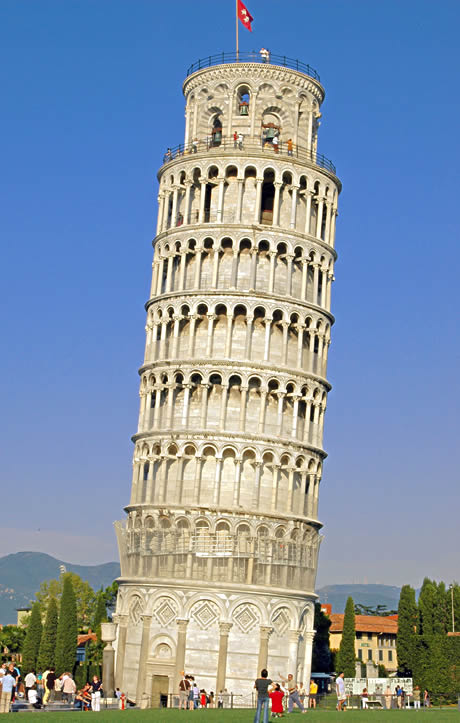The Leaning Tower of Pisa

There are several particularities which render the Leaning Tower of Pisa a genuine tourist objective, despite the fact that some say this tower unjustifiably overshadows the rest of the historic and architectural heritage of Pisa. First of all, of all the leaning towers in the world – summing up to more than 30 – the one in Pisa is often taken for the only structure of this kind to feature such a particularity. Indeed, it is the only tower in the world which has managed to capitalize its flaw and turn it into a tourist asset. Second of all, despite some people’s believes, the lean of the tower is indeed the result of an error in conceiving the foundation of the structure and in setting out from the beginning its emplacement on an extremely poor site unable to sustain a construction with such features.
The tower is some 56 meters high on the low side, and almost 57 meters on the upper side, its present inclination measuring no less than 3,99 degrees. The 14,500 ton weight of the tower is sustained by an outer base diameter of only about 16 meters. Thirdly, it took Pisa almost two centuries to entirely build the tower (from 1173 to 1372, when the bell chamber was added to the tower), the history of the structure being intertwined with the history of Pisa as such, certain moments of troubled historic circumstances pegging out – more or less fortunately – the rhythm of the construction works. Moreover, the history of the construction works as such can not, in this case, be separated from the history of the attempts to correct the lean, which, for that matter, started to become noticeable when the tower reached to its third floor, in 1178. Fortunately, from that moment on, the construction works were interrupted for about a century, Pisa being constantly at war with its Tuscan neighbors, such as Florence and Lucca, and with a northerner city, namely, Genoa. This intermittence gave the soil on which the tower was built time to settle, but no noticeable progress as to the correction attempts was made; on the contrary, all efforts to redress the verticality of the tower only made the conditions worse. Yet, the erection of this structure continued, and concluded in 1372, when the bell chamber was also finished.

But such technicalities aside, the tower also takes pride in being the third oldest structure in Pisa, next to the Pisa Cathedral (Cattedrale / Il Duomo di Pisa) and to the Baptistery, respectively, together yielding the main highlights in the Piazza del Duomo or, as some prefer to call this square, the Field of Miracles. Indeed, the intended use of the Leaning Tower was of servicing as campanile for the Pisa Cathedral, which, finally, it did. This is why the Tower was fitted with seven bells, each of these being referred to with a certain appellative and tuned to the musical scale. The last of these bells was brought to the tower in early 18th century. Another intriguing feature of the Leaning Tower concerns the dispute with respect to the original architect of the structure. Some theories indicate one of the Pisano artists, more precisely, Bonanno Pisano, as chief architect of the tower, yet others consider Diotisalvi is a much more plausible hypothesis since the latter is also ascertained as designer of the Baptistery and of another noteworthy tower in Pisa, namely, the bell tower pertaining to the Church of San Nicola. Finally, no theory consistent with the facts has yet been conceived. On the other hand, Pisa owes to Giovanni di Simone the resuming of the construction works in late 13th century, and to another Pisano artist, namely, Andrea Pisano, the completion of the tower, who excelled in finding the most balanced formula between the Gothic dash of the bell chamber and the overall Romanesque stature of the structure.
Nowadays, tourism authorities in Pisa don’t even want to correct the lean any more, since this is the only reason the tower is so enticing for the large public. In fact, they insist on not addressing this issue or, at least, on not correcting it to the extent of eliminating it. Briefly, the Leaning Tower makes a good reason for visiting Pisa, being, in fact, the only genuine objective which should never be overlooked since, indeed, it is the closest thing to the idea of symbol of Pisa.
Go to top